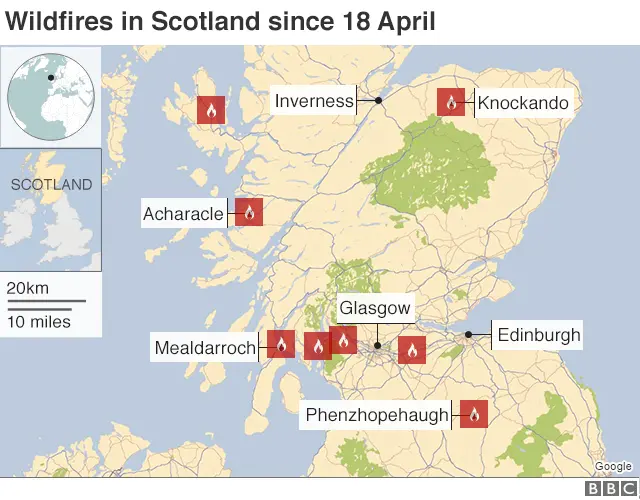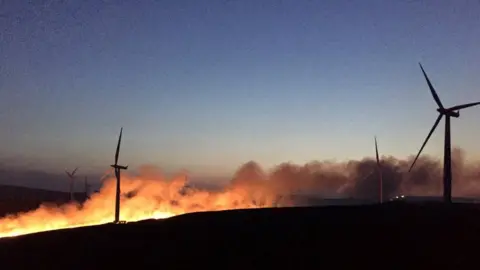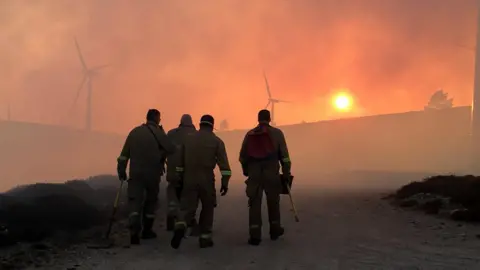Fighting fire with fire to tackle Scotland's wildfires
 Carrbridge Fire Station
Carrbridge Fire StationWildfires in Scotland are to be tackled by controlled burning for the first time.
The increasing threat of wildfires has forced the fire service to begin training staff in the fire management method common in hot countries.
The Scottish Fire and Rescue Service (SFRS) issued 21 wildfire danger warnings last year.
The service has warned climate change means wildfires are likely to be become more common in Scotland.
Area manager Bruce Farquharson, who helped to coordinate the response this week to a major wildfire in Moray, one of the largest in the UK for years, said: "What we have seen over the last week is not surprising.
"When we have a cold winter, combined with easterly winds and then a warm spring - that is an ideal storm for wildfires to happen.
"Climate change is a factor, we are going to see drier winters and warmer springs so we are going to need to change the way we deal with wildfires."

The SFRS last year issued 21 fire danger warnings, which combine data about ground and weather conditions to predict the likelihood of wildfires.
In 2017 only six warnings were issued and the year before there were only two.
So far this year four warnings have been issued by the service, which has dealt with eight major wildfires since 18 April alone.
 UK National Centre for Earth Observation
UK National Centre for Earth Observation SFRS
SFRSMr Farquharson said the gravity of the threat now meant firefighters were being trained in controlled burning with a view to formally starting the practice next spring, most likely in the worst affected areas of the Highlands and Aberdeenshire.
Controlled burning involves creating fires to remove the fuel, typically heather or grass, which keeps wildfires burning and forcing them to burn out.
It is a technique that is used in countries that have severe wildfires, such as Australia or the United States, which had devastating fires in California last year.
In the UK, the South Wales Fire and Rescue service starting using the method last year and was called in to help with the major Saddleworth Moor fire which occurred during the 2018 heatwave.
 Reuters
ReutersMr Farquharson tried the method himself in Spain last year where he and local firefighters put out a blaze covering several acres of scrubland on a remote hill without using a single drop of water.
He explained: "It might sound a bit odd to some but what we are aiming to do is to teach some of our key stations how to use fire to fight wildfires.
"You clear a strip of vegetation as a base using hand tools and you slowly burn back from that to create an ever widening area of what we call a black strip so that when the fire reaches this strip, it burns out itself.
"Gamekeepers have traditionally done it but the fire service has never done it in Scotland before."
 SFRS
SFRS'Leaf blowers are an awesome tool'
Working smarter to try and reduce the amount of "back breaking work" needed to deal with wildfires has also thrown up a perhaps unlikely new ally for firefighters- the leaf blower.
Mr Farquharson, who is also chairman of the Scottish Wildfire Forum, continued: "The firefighters coming off the hill at Moray looked like they have been at war.
"That is why we are keen to get the controlled fire approach working but there are other methods, industrial standard leaf blowers are an awesome tool.
"Not on all fuel types, but certainly on heather and some types of grass, a leaf blower does the same job as beating a fire.
"Think about a birthday cake and blowing the candles out, a leaf blower does the same job and two people with leaf blowers can do same job as ten people with traditional beaters, in a fraction of the time."
 SFRS
SFRSThe fire service is keen to increase public awareness of the dangers of wildfires and would also like to see a network of signs erected at popular countryside spots which tell people the current status of the wildfire threat.
Mr Farquharson said better education of visitors to the countryside was also needed.
He said: "Disposable barbeques remain a problem but also the increase in wild camping can create issues, such as what appears to be a decrease in the knowledge of how to build and run a safe camp fire."
